2006 CHEVROLET EQUINOX steering wheel
[x] Cancel search: steering wheelPage 243 of 382

Towing a trailer requires a certain amount of experience.
Before setting out for the open road, you will want to
get to know your rig. Acquaint yourself with the feel of
handling and braking with the added weight of the trailer.
And always keep in mind that the vehicle you are
driving is now a good deal longer and not nearly as
responsive as your vehicle is by itself.
Before you start, check all trailer hitch parts and
attachments, safety chains, electrical connector, lamps,
tires and mirror adjustment. If the trailer has electric
brakes, start your vehicle and trailer moving and then
apply the trailer brake controller by hand to be sure
the brakes are working. This lets you check your
electrical connection at the same time.
During your trip, check occasionally to be sure that the
load is secure, and that the lamps and any trailer
brakes are still working.
Following Distance
Stay at least twice as far behind the vehicle ahead as
you would when driving your vehicle without a trailer.
This can help you avoid situations that require
heavy braking and sudden turns.
Passing
You will need more passing distance up ahead when
you are towing a trailer. And, because you are a
good deal longer, you will need to go much farther
beyond the passed vehicle before you can return to
your lane.
Backing Up
Hold the bottom of the steering wheel with one hand.
Then, to move the trailer to the left, just move that hand
to the left. To move the trailer to the right, move your
hand to the right. Always back up slowly and, if possible,
have someone guide you.
Making Turns
Notice:Making very sharp turns while trailering
could cause the trailer to come in contact with
the vehicle. Your vehicle could be damaged.
Avoid making very sharp turns while trailering.
When you are turning with a trailer, make wider turns
than normal. Do this so your trailer will not strike soft
shoulders, curbs, road signs, trees or other objects.
Avoid jerky or sudden maneuvers. Signal well in advance.
4-43
Page 296 of 382
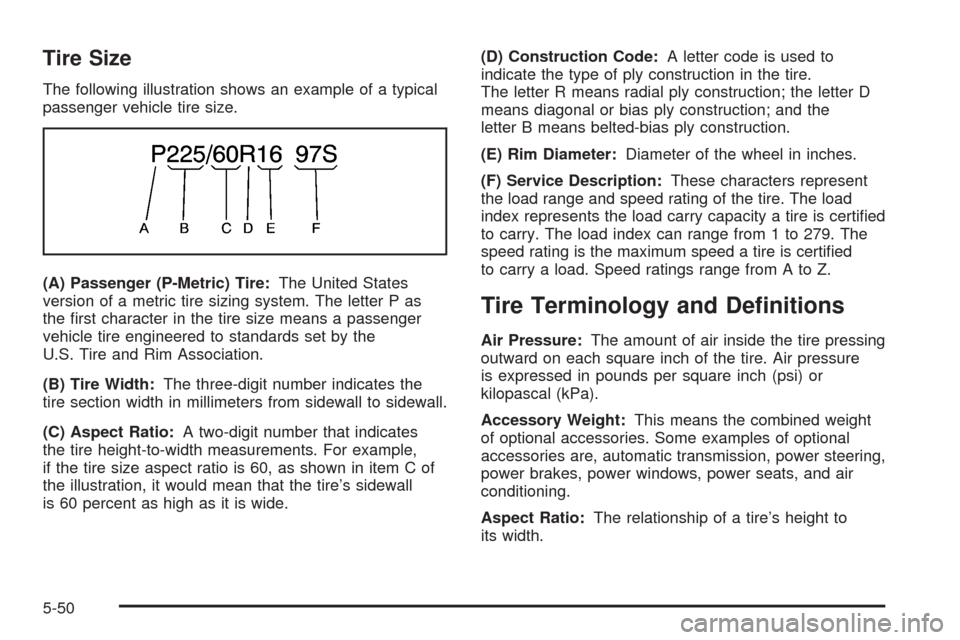
Tire Size
The following illustration shows an example of a typical
passenger vehicle tire size.
(A) Passenger (P-Metric) Tire:The United States
version of a metric tire sizing system. The letter P as
the �rst character in the tire size means a passenger
vehicle tire engineered to standards set by the
U.S. Tire and Rim Association.
(B) Tire Width:The three-digit number indicates the
tire section width in millimeters from sidewall to sidewall.
(C) Aspect Ratio:A two-digit number that indicates
the tire height-to-width measurements. For example,
if the tire size aspect ratio is 60, as shown in item C of
the illustration, it would mean that the tire’s sidewall
is 60 percent as high as it is wide.(D) Construction Code:A letter code is used to
indicate the type of ply construction in the tire.
The letter R means radial ply construction; the letter D
means diagonal or bias ply construction; and the
letter B means belted-bias ply construction.
(E) Rim Diameter:Diameter of the wheel in inches.
(F) Service Description:These characters represent
the load range and speed rating of the tire. The load
index represents the load carry capacity a tire is certi�ed
to carry. The load index can range from 1 to 279. The
speed rating is the maximum speed a tire is certi�ed
to carry a load. Speed ratings range from A to Z.
Tire Terminology and De�nitions
Air Pressure:The amount of air inside the tire pressing
outward on each square inch of the tire. Air pressure
is expressed in pounds per square inch (psi) or
kilopascal (kPa).
Accessory Weight:This means the combined weight
of optional accessories. Some examples of optional
accessories are, automatic transmission, power steering,
power brakes, power windows, power seats, and air
conditioning.
Aspect Ratio:The relationship of a tire’s height to
its width.
5-50
Page 308 of 382
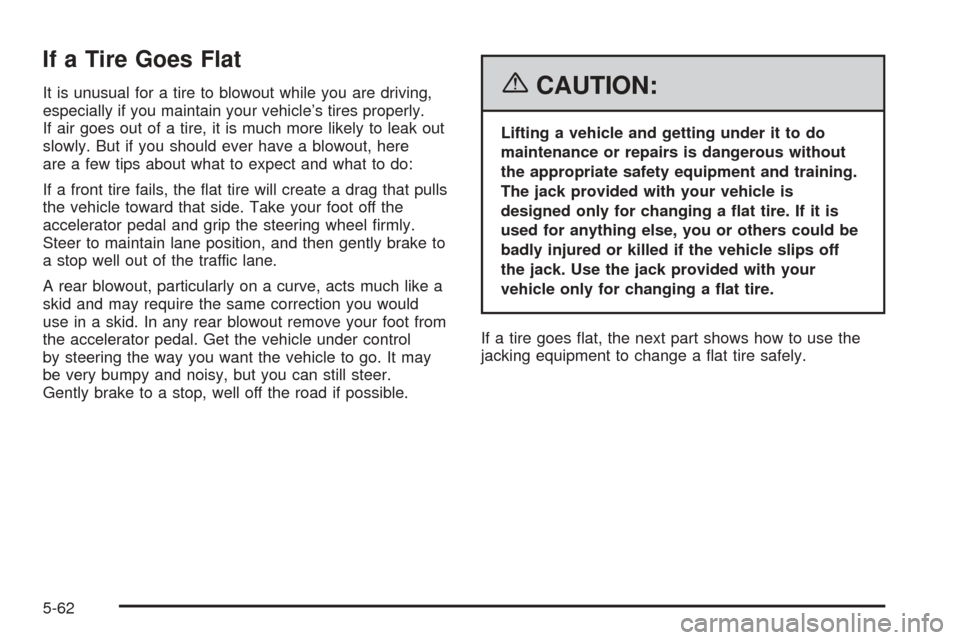
If a Tire Goes Flat
It is unusual for a tire to blowout while you are driving,
especially if you maintain your vehicle’s tires properly.
If air goes out of a tire, it is much more likely to leak out
slowly. But if you should ever have a blowout, here
are a few tips about what to expect and what to do:
If a front tire fails, the �at tire will create a drag that pulls
the vehicle toward that side. Take your foot off the
accelerator pedal and grip the steering wheel �rmly.
Steer to maintain lane position, and then gently brake to
a stop well out of the traffic lane.
A rear blowout, particularly on a curve, acts much like a
skid and may require the same correction you would
use in a skid. In any rear blowout remove your foot from
the accelerator pedal. Get the vehicle under control
by steering the way you want the vehicle to go. It may
be very bumpy and noisy, but you can still steer.
Gently brake to a stop, well off the road if possible.{CAUTION:
Lifting a vehicle and getting under it to do
maintenance or repairs is dangerous without
the appropriate safety equipment and training.
The jack provided with your vehicle is
designed only for changing a �at tire. If it is
used for anything else, you or others could be
badly injured or killed if the vehicle slips off
the jack. Use the jack provided with your
vehicle only for changing a �at tire.
If a tire goes �at, the next part shows how to use the
jacking equipment to change a �at tire safely.
5-62
Page 343 of 382
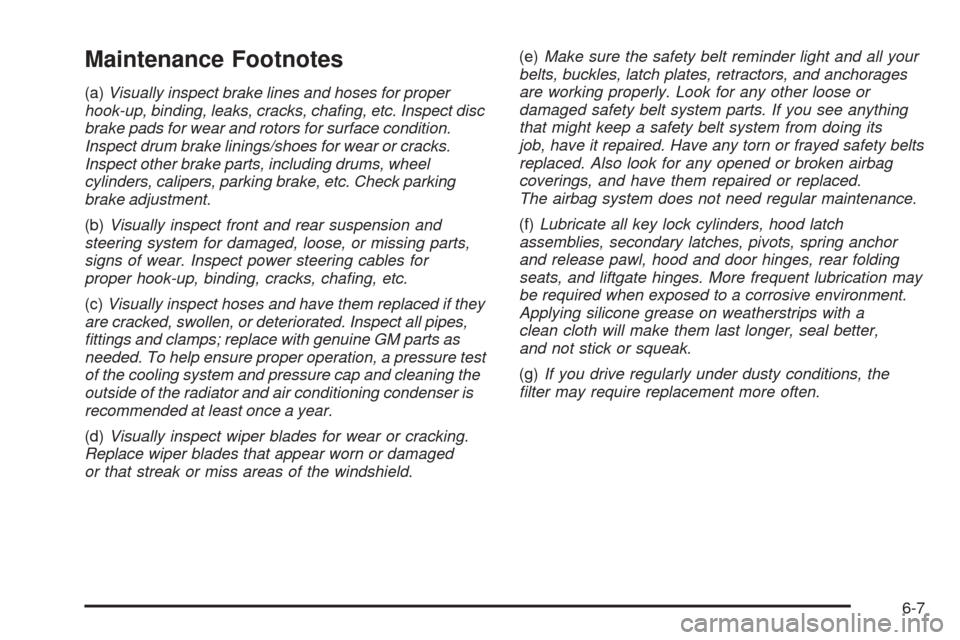
Maintenance Footnotes
(a)Visually inspect brake lines and hoses for proper
hook-up, binding, leaks, cracks, cha�ng, etc. Inspect disc
brake pads for wear and rotors for surface condition.
Inspect drum brake linings/shoes for wear or cracks.
Inspect other brake parts, including drums, wheel
cylinders, calipers, parking brake, etc. Check parking
brake adjustment.
(b)Visually inspect front and rear suspension and
steering system for damaged, loose, or missing parts,
signs of wear. Inspect power steering cables for
proper hook-up, binding, cracks, cha�ng, etc.
(c)Visually inspect hoses and have them replaced if they
are cracked, swollen, or deteriorated. Inspect all pipes,
�ttings and clamps; replace with genuine GM parts as
needed. To help ensure proper operation, a pressure test
of the cooling system and pressure cap and cleaning the
outside of the radiator and air conditioning condenser is
recommended at least once a year.
(d)Visually inspect wiper blades for wear or cracking.
Replace wiper blades that appear worn or damaged
or that streak or miss areas of the windshield.(e)Make sure the safety belt reminder light and all your
belts, buckles, latch plates, retractors, and anchorages
are working properly. Look for any other loose or
damaged safety belt system parts. If you see anything
that might keep a safety belt system from doing its
job, have it repaired. Have any torn or frayed safety belts
replaced. Also look for any opened or broken airbag
coverings, and have them repaired or replaced.
The airbag system does not need regular maintenance.
(f)Lubricate all key lock cylinders, hood latch
assemblies, secondary latches, pivots, spring anchor
and release pawl, hood and door hinges, rear folding
seats, and liftgate hinges. More frequent lubrication may
be required when exposed to a corrosive environment.
Applying silicone grease on weatherstrips with a
clean cloth will make them last longer, seal better,
and not stick or squeak.
(g)If you drive regularly under dusty conditions, the
�lter may require replacement more often.
6-7
Page 369 of 382
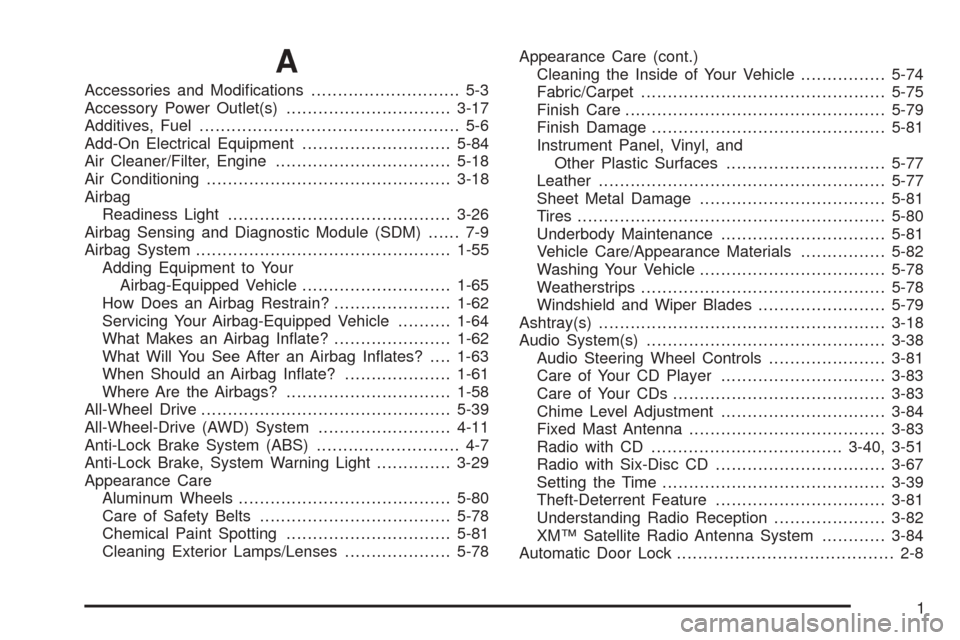
A
Accessories and Modi�cations............................ 5-3
Accessory Power Outlet(s)...............................3-17
Additives, Fuel................................................. 5-6
Add-On Electrical Equipment............................5-84
Air Cleaner/Filter, Engine.................................5-18
Air Conditioning..............................................3-18
Airbag
Readiness Light..........................................3-26
Airbag Sensing and Diagnostic Module (SDM)...... 7-9
Airbag System................................................1-55
Adding Equipment to Your
Airbag-Equipped Vehicle............................1-65
How Does an Airbag Restrain?......................1-62
Servicing Your Airbag-Equipped Vehicle..........1-64
What Makes an Airbag In�ate?......................1-62
What Will You See After an Airbag In�ates?....1-63
When Should an Airbag In�ate?....................1-61
Where Are the Airbags?...............................1-58
All-Wheel Drive...............................................5-39
All-Wheel-Drive (AWD) System.........................4-11
Anti-Lock Brake System (ABS)........................... 4-7
Anti-Lock Brake, System Warning Light..............3-29
Appearance Care
Aluminum Wheels........................................5-80
Care of Safety Belts....................................5-78
Chemical Paint Spotting...............................5-81
Cleaning Exterior Lamps/Lenses....................5-78Appearance Care (cont.)
Cleaning the Inside of Your Vehicle................5-74
Fabric/Carpet..............................................5-75
Finish Care.................................................5-79
Finish Damage............................................5-81
Instrument Panel, Vinyl, and
Other Plastic Surfaces..............................5-77
Leather......................................................5-77
Sheet Metal Damage...................................5-81
Tires..........................................................5-80
Underbody Maintenance...............................5-81
Vehicle Care/Appearance Materials................5-82
Washing Your Vehicle...................................5-78
Weatherstrips..............................................5-78
Windshield and Wiper Blades........................5-79
Ashtray(s)......................................................3-18
Audio System(s).............................................3-38
Audio Steering Wheel Controls......................3-81
Care of Your CD Player...............................3-83
Care of Your CDs........................................3-83
Chime Level Adjustment...............................3-84
Fixed Mast Antenna.....................................3-83
Radio with CD....................................3-40, 3-51
Radio with Six-Disc CD................................3-67
Setting the Time..........................................3-39
Theft-Deterrent Feature................................3-81
Understanding Radio Reception.....................3-82
XM™ Satellite Radio Antenna System............3-84
Automatic Door Lock......................................... 2-8
1
Page 379 of 382
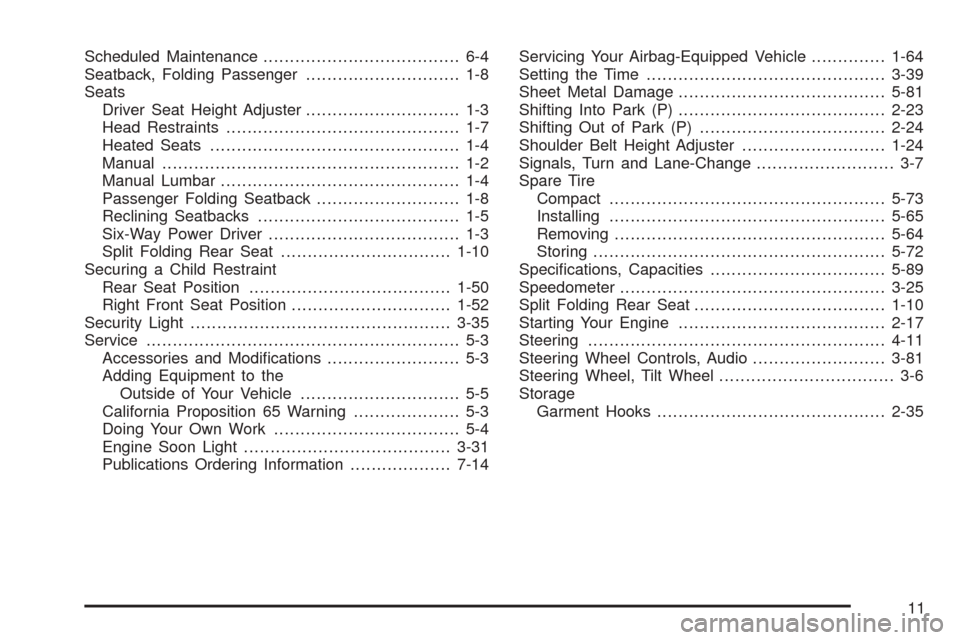
Scheduled Maintenance..................................... 6-4
Seatback, Folding Passenger............................. 1-8
Seats
Driver Seat Height Adjuster............................. 1-3
Head Restraints............................................ 1-7
Heated Seats............................................... 1-4
Manual........................................................ 1-2
Manual Lumbar............................................. 1-4
Passenger Folding Seatback........................... 1-8
Reclining Seatbacks...................................... 1-5
Six-Way Power Driver.................................... 1-3
Split Folding Rear Seat................................1-10
Securing a Child Restraint
Rear Seat Position......................................1-50
Right Front Seat Position..............................1-52
Security Light.................................................3-35
Service........................................................... 5-3
Accessories and Modi�cations......................... 5-3
Adding Equipment to the
Outside of Your Vehicle.............................. 5-5
California Proposition 65 Warning.................... 5-3
Doing Your Own Work................................... 5-4
Engine Soon Light.......................................3-31
Publications Ordering Information...................7-14Servicing Your Airbag-Equipped Vehicle..............1-64
Setting the Time.............................................3-39
Sheet Metal Damage.......................................5-81
Shifting Into Park (P).......................................2-23
Shifting Out of Park (P)...................................2-24
Shoulder Belt Height Adjuster...........................1-24
Signals, Turn and Lane-Change.......................... 3-7
Spare Tire
Compact....................................................5-73
Installing....................................................5-65
Removing...................................................5-64
Storing.......................................................5-72
Speci�cations, Capacities.................................5-89
Speedometer..................................................3-25
Split Folding Rear Seat....................................1-10
Starting Your Engine.......................................2-17
Steering........................................................4-11
Steering Wheel Controls, Audio.........................3-81
Steering Wheel, Tilt Wheel................................. 3-6
Storage
Garment Hooks...........................................2-35
11